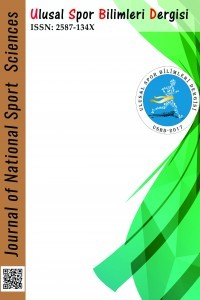Merkez Bölge (Kor) Kas Kuvvetinin Değerlendirilmesi için İzometrik Test Bataryasının Geliştirilmesi ve Geçerliliğinin Sağlanması
Çalışmanın amacı kor kaslarında kuvvetinin değerlendirilmesi için tasarlanmış izometrik bir test bataryasının geliştirilmesi ve geçerliliğinin sağlanmasıdır. Araştırmaya yaş ortalamaları 24,25±1,91 yıl olan düzenli olarak spor yapmayan toplam 30 birey gönüllü olarak katılmıştır. Çalışmada yer alan tüm katılımcılara kuvvet testlerinden önce 10 dk ısınma yaptırılmıştır. Merkez bölgesi için toplam 8 hareket test olarak uygulanmış ve 2 adet merkez kuvveti ölçen geçerliliği ve güvenirliliği olan mekik ve sırt kuvvet testi ile karşılaştırılmıştır. 10 testin bitiminden 1 hafta sonra 8 test aynı sıra ile tüm katılımcılara uygulanarak son testler tamamlanmıştır. Çalışmanın sonunda kor bölgesi kuvvet antrenmanlarında kullanılan plank, crunch, çakı, çapraz kol ve bacak, topuğa değme, çift bacak yukarı kaldırma hareketlerinin izometrik kuvvet testi olarak kullanılması önerilmektedir.
Anahtar Kelimeler:
kuvvet, Kor bölgesi, izometrik test
Development and Validity of Izometric Test Battery for the Evaluation of Core Muscle Force
The aim of the study was to provide the development and validation of an isometric test battery for the evaluation of the strength of the core muscles. Average age of the study was 24,25±1,91 years and 30 individuals participated voluntarily. In the study all the participants were warmed up for 10 minutes before all participating force tests. A total of 8 motion tests were performed for the core muscles and the validity and reliability of the 2 central force measures were compared with the force test. After 1 week from the end of 10 tests, 8 tests were applied to all participants in the same order and the final tests were completed. It is recommended that isometric strength tests of plank, crunch, v ups, abbikef, heel touch, legraise movements used in core strength training at the end of the study
Keywords:
Core, strength, isometric test,
___
- Axel TA, 2013. The effects of a core strength training program on field testing performance outcomes in junior elite surf athletes, California State University, Long Beach, 89; 1523042
- Behm DG, Drinkwater EJ, Willardson JM, Cowley PM. 2010. The use of instability to train the core musculature , Appl. Physiol. Nutr. Metab. 35: 91–108 (2010)
- Hibbs AE, Thompson KG, French D, Wrigley A, & Spear L, 2008. Optimizing Performance by Improving Core Stability and Core Strength. Sports Med, 38(12), 995-1008.
- Nesser TW, Huxel KC, Tincher JL, Okada T, 2008. The relationship between core stability and performance in Division I football players. J, Strength Cond Res.; 22:1750 1754.
- Samson MK 2005. The Effects of a Five-Week Core Stabilization-Training Program on Dynamic Balance in Tennis Athletes, Master’s Thesis, West Virginia University. Santana JC, 2005. Strength training for swimmers: Training the core. Clin J Sport Med, 2(27):40–42. Xue-Qiang Wang, Jie-Jiao Zheng, Zhuo-Wei Yu , Xia Bi , Shu-Jie Lou , Jing Liu , Bin Cai, Ying Hui Hua, Mark Wu, Mao-Ling Wei , Hai-Min Shen, Yi Chen, Yu-Jian Pan, Guo-Hui Xu , Pei-Jie Chen, 2012. A Meta-Analysis of Core Stability Exercise versus General Exercise for Chronic Low Back Pain, Plos One, December, Volume 7, Issue 12.
- Başlangıç: 2016
- Yayıncı: Pınar GÜZEL
Sayıdaki Diğer Makaleler
Düzenli Egzersiz Yapan Bireylerin Beslenme Alışkanlıklarının İncelenmesi
Nurten DİNÇ, Mehmet Hilmi GÖKMEN, Esin ERGİN
Necla ALTINOK, Asuman ŞAHAN, K.alparslan ERMAN, Ahmet UZUN
Boş Zaman Davranışını Açıklamaya Işık Tutan Kuramsal Yaklaşımlar
Süleyman MUNUSTURLAR, Bilal KURNAZ, Gökhan YAVUZ, Özlem ÖZCAN, Buse KARAŞ
